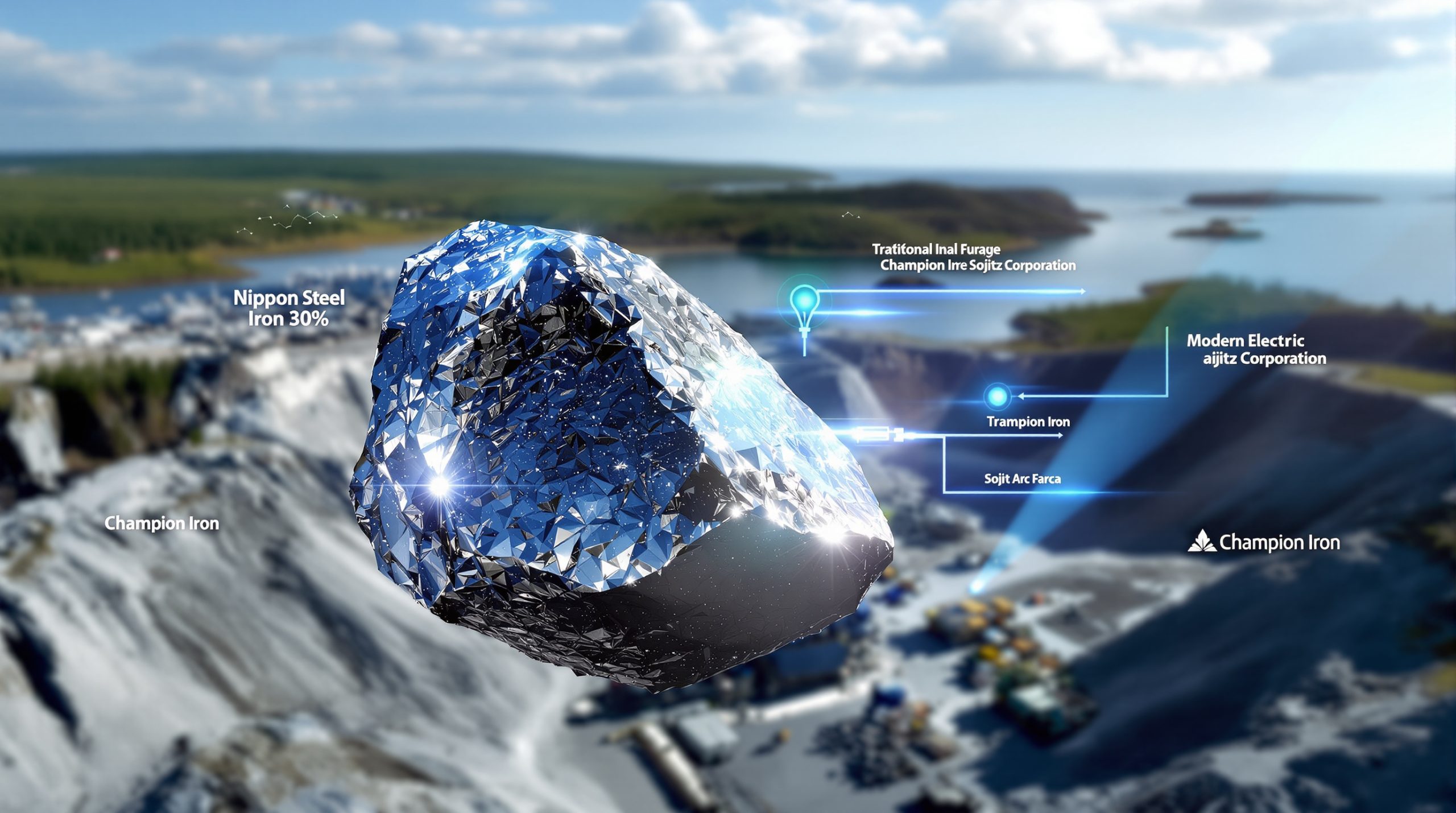How Collaboration is Reshaping Critical Minerals Supply Chains
The global critical minerals landscape is undergoing a profound transformation as nations recognize the strategic importance of these resources. With growing demand for technologies essential to the energy transition security, collaboration has emerged as a crucial strategy for building resilient supply chains.
The Geopolitical Reality of Critical Minerals
Why Geography Trumps Politics in Mineral Access
Critical minerals follow geological distribution patterns that exist independent of political boundaries. This fundamental reality creates an unavoidable interdependence among nations seeking to secure these resources. According to Raj Surendran, CEO of Tianqi Lithium Energy Australia, "Commodities by nature are globally traded. They follow geology, not ideology. You can't relocate a lithium deposit based on a foreign policy that's being crafted at the moment" (Fastmarkets, 2025).
The natural distribution of minerals creates a situation where complete independence is virtually impossible. Even resource-rich nations like Australia, Canada, and the United States lack the full spectrum of critical minerals needed for energy transition technologies. For example, while Australia possesses significant lithium deposits, it relies on other nations for rare earth elements essential for wind turbines and electric motors.
The Challenge of Complete Decoupling
The concept of fully independent supply chains faces significant practical obstacles:
-
Mineral deposits cannot be relocated based on foreign policy preferences
-
Building new processing infrastructure requires enormous capital investment, often exceeding $500 million for a single facility
-
Technical expertise and specialized knowledge remain concentrated in specific regions, particularly in Asia
-
Market efficiency typically favors established supply routes despite geopolitical tensions
Industry analysts point out that complete decoupling from existing supply chains is not only economically impractical but potentially counterproductive. A more balanced approach focused on diversification and strategic partnerships offers greater resilience without sacrificing efficiency.
China's Strategic Position: Understanding the Reality
Decades of Deliberate Industrial Policy
China's dominance in critical minerals processing didn't happen by accident. It represents the culmination of:
-
Long-term strategic planning spanning multiple decades, beginning in the 1980s with the establishment of the 863 Program focused on technological development
-
Substantial investments in midstream processing capacity, with billions allocated to develop refining capabilities
-
Willingness to absorb environmental and economic costs of refining that other nations were reluctant to bear
-
Development of integrated industrial ecosystems connecting mining, refining, manufacturing, and recycling
This comprehensive approach allowed China to establish a commanding position in processing and refining for nearly all critical minerals, controlling up to 80% of global rare earth element processing and 60% of lithium refining capacity.
Beyond Simple Narratives
Rather than viewing China's position as merely a monopolistic strategy, it's more accurately understood as a value chain built through sustained investment and policy focus—one that Western nations are now attempting to replicate. As Surendran explains, "The reality is China's dominance is the result of decades of strategic industrial policy, investment in the midstream capacity and development, and a willingness to take on the environmental and economic cost of refining" (Fastmarkets, 2025).
This perspective shifts the conversation from simplistic competition narratives to one of capability development. Western nations are not just competing with China but working to build their own processing expertise and capacity—a process that requires time, investment, and often, collaboration in critical minerals supply chain with existing knowledge centers.
Key Barriers to Building Alternative Supply Chains
Operational Challenges Facing Western Nations
| Challenge | Description |
|---|---|
| Feedstock Security | Ensuring reliable access to raw materials through long-term contracts or direct ownership |
| Permitting Delays | Navigating complex regulatory environments that can extend project timelines by 3-5 years |
| Financing Gaps | Securing patient capital for long-term investments with uncertain returns |
| Technical Expertise | Addressing shortages in specialized knowledge, particularly in chemical processing |
| Industrial Ecosystem | Building supporting infrastructure and networks to create efficient value chains |
These barriers represent significant hurdles for companies and governments working to establish alternative supply chains. The regulatory environment in Western nations, while important for environmental and social protections, often creates competitive disadvantages in terms of speed to market and operational costs.
The Processing Bottleneck
While establishing new mining operations presents its own challenges, the more significant hurdle lies in developing processing capacity, technical expertise, and downstream integration. These elements require time, investment, and knowledge transfer that cannot be accelerated simply through policy directives.
Industry experts note that building new mines typically takes 7-10 years from discovery to production, but developing the technical expertise to process minerals efficiently can take even longer. As Surendran emphasizes, "Building new mines is one thing, but building that processing capacity, the technical expertise and the downstream integration, that's where the real challenge lies" (Fastmarkets, 2025).
This processing bottleneck represents perhaps the most significant obstacle to supply chain diversification, as it requires not just capital but specialized knowledge that has been developed over decades in existing processing centers.
Why Collaboration Offers a More Pragmatic Path
From Decoupling to Diversification
Rather than pursuing complete separation from existing supply chains, industry leaders advocate for a more nuanced approach focused on:
-
Diversification of supply sources to reduce concentration risk
-
Building redundancy into critical systems through parallel processing capabilities
-
Developing strategic partnerships across geopolitical lines to leverage existing expertise
-
Creating resilience through multiple supply options rather than isolated national systems
This shift from "decoupling" rhetoric to "diversification" strategy represents a more pragmatic approach to supply chain security. It acknowledges the reality that global interdependence in mineral supply chains is not a weakness to be eliminated but a characteristic to be managed through strategic partnerships and redundant systems.
The Joint Venture Model
Collaborative ventures that bridge different regulatory environments and business cultures can offer significant advantages:
-
Access to established technical expertise that would take years to develop independently
-
More efficient capital deployment through shared investment models
-
Faster time-to-market for new projects by leveraging existing operational knowledge
-
Balanced approach to geopolitical risk management through diversified ownership structures
Joint ventures between Western and Asian companies provide a framework for knowledge transfer while maintaining appropriate safeguards for intellectual property and strategic technologies. Tianqi Lithium Energy Australia serves as an example of this collaborative model, combining Chinese investment with Australian operations to create a more resilient supply chain solution.
The Market Reality: Cost vs. Security Considerations
Economic Factors Still Drive Decisions
Despite growing emphasis on supply chain security, economic considerations remain paramount in purchasing decisions. As Surendran observed, while there's discussion about premiums for non-Chinese supply, "cost still wins just about every time" (Fastmarkets, 2025).
This market reality presents a challenge for alternative supply chains that typically face higher operational costs due to:
-
Stricter environmental and labor regulations in Western jurisdictions
-
Higher energy costs in regions without subsidized power
-
Less developed infrastructure and industrial ecosystems
-
Higher financing costs for new projects perceived as higher risk
For alternative supply chains to succeed long-term, they must find ways to remain cost-competitive while delivering on security and sustainability promises. This often requires innovative business models that can capture value beyond simple commodity pricing.
Building Trust Through Transparency
In this complex environment, companies that can provide:
-
Full supply chain traceability from mine to manufacturing
-
Rigorous compliance documentation meeting global standards
-
Adherence to global ESG standards with third-party verification
-
Transparent reporting on social and environmental impacts
are building the foundation for trusted partnerships that can withstand geopolitical pressures. This transparency creates value that can sometimes offset higher production costs, particularly for end-users with strong sustainability commitments or regulatory requirements.
Regional Collaboration Initiatives Gaining Momentum
Government-Led Partnerships
Several formal initiatives have emerged to foster international cooperation:
-
The Minerals Security Partnership (MSP) brings together 14 countries including the United States, Japan, South Korea, and European nations to coordinate investment in critical minerals projects
-
EU-US Trade and Technology Council has established working groups focused on critical minerals cooperation and supply chain resilience
-
Japan-Australia Critical Minerals Partnership supports joint development projects with financing and technical support
-
Canada-European Union Strategic Partnership on Raw Materials coordinates policy approaches and investment strategies
These government-led initiatives provide policy frameworks and often financing support for collaborative ventures in critical minerals. They represent a shift from purely national approaches to more coordinated international strategies that recognize the inherently global nature of mineral supply chains.
Industry Consortiums
Private sector collaboration is also accelerating:
-
Automotive manufacturers forming direct partnerships with mining companies to secure supply, with investments exceeding $15 billion since 2021
-
Battery producers establishing joint ventures with materials suppliers across national boundaries
-
Technology companies investing in mineral processing facilities to ensure component availability
-
Cross-border recycling initiatives creating circular economy solutions for critical minerals
These industry-led collaborations often move faster than government initiatives and can be more responsive to market conditions. They represent pragmatic approaches to supply chain challenges that balance security concerns with commercial realities.
Case Study: Successful Cross-Border Collaboration Models
Australian-Chinese Joint Ventures
Several successful partnerships demonstrate how cross-border collaboration can function effectively:
-
Joint ventures that combine Chinese processing expertise with Australian mining capabilities, such as Tianqi Lithium Energy Australia
-
Transparent governance structures that satisfy regulatory requirements in both jurisdictions while maintaining operational efficiency
-
Clear ESG frameworks that meet Western standards while leveraging global efficiencies in processing and logistics
-
Knowledge transfer arrangements that build local capacity while respecting intellectual property rights
These collaborative models demonstrate how companies can navigate complex geopolitical environments while building more resilient supply chains. They offer templates for future partnerships that can bridge different regulatory systems and business cultures.
Lessons Learned
Key insights from successful collaborations include:
-
Importance of clear governance structures with balanced representation
-
Need for transparent communication with stakeholders, including governments
-
Value of cultural alignment and shared objectives among partners
-
Benefits of phased approaches that build trust before expanding operations
-
Necessity of robust ESG frameworks that satisfy diverse regulatory requirements
These lessons provide valuable guidance for companies considering collaborative approaches to critical minerals supply chains. They highlight both the challenges and potential benefits of cross-border partnerships in this complex sector.
The Path Forward: A Balanced Global Supply Chain
Vision for 2030 and Beyond
Industry leaders envision a future where:
-
China remains a major player but not the dominant force, with its share of processing capacity declining from current levels of 60-80% to perhaps 40-50%
-
New capacity emerges in Africa, Latin America, and Southeast Asia, creating a more distributed global processing network
-
Western processing capabilities expand to create genuine alternatives, particularly for specialized materials with strategic importance
-
Transparent and commercially governed partnerships become the norm, reducing geopolitical risk through diversified ownership
This more balanced ecosystem would provide greater resilience while maintaining the efficiency benefits of global trade. It represents a pragmatic middle path between complete decoupling and continued overreliance on single-source supply chains.
Companies Positioned to Thrive
Organizations that can successfully navigate both Western regulatory environments and global supply chain realities will be best positioned to capitalize on the energy transition. This requires:
-
Sophisticated understanding of geopolitical dynamics and their impact on supply chain strategies
-
Ability to meet rigorous ESG standards while remaining cost-competitive in global markets
-
Flexibility to adapt to evolving regulatory landscapes across multiple jurisdictions
-
Commitment to transparency and traceability throughout the supply chain
Companies that develop these capabilities will find opportunities in an environment where security concerns must be balanced with commercial realities. Their success will depend not just on what they produce but how they produce it and with whom they partner.
What This Means for Stakeholders
For Policymakers
-
Focus on creating enabling environments for investment through streamlined permitting processes and regulatory certainty
-
Develop regulatory frameworks that encourage responsible collaboration rather than arbitrary restrictions based on national origin
-
Balance security concerns with practical market realities, recognizing that extreme positions may undermine intended outcomes
-
Support knowledge transfer and workforce development to build local processing capabilities over the medium to long term
-
Provide targeted financial support for strategic projects that advance national interests while respecting market mechanisms
Effective policy approaches will recognize the inherently global nature of mineral supply chains while working to reduce vulnerabilities through diversification rather than isolation.
For Industry Participants
-
Pursue strategic partnerships that bridge geopolitical divides while maintaining appropriate safeguards
-
Invest in transparency and traceability systems to build trust with customers and regulators
-
Develop redundancy in critical supply chains through diversified sourcing and processing options
-
Balance cost considerations with security needs through innovative business models and value-added services
-
Engage proactively with policymakers to shape realistic regulatory frameworks
Companies that take these actions will be better positioned to navigate the complex landscape of critical minerals supply chains, turning potential challenges into competitive advantages.
For Investors
-
Evaluate companies based on their collaborative approaches and ability to navigate complex regulatory environments
-
Consider both geopolitical risks and partnership opportunities when assessing long-term viability
-
Look for organizations that can bridge different business cultures and regulatory systems
-
Recognize the value of diversified supply chain strategies in reducing concentration risk
-
Be willing to provide patient capital for strategic projects with long development timelines
Investors who understand these dynamics will identify opportunities that others miss, particularly in collaborative ventures that combine Western standards with global efficiency.
Conclusion: Pragmatism Over Politics
The future of critical minerals supply chains will likely be shaped not by ideological positions but by practical realities. While security concerns are legitimate, the most successful approaches will recognize the unavoidable interdependence of global markets and the value of strategic collaboration.
By focusing on diversification rather than decoupling, stakeholders can build resilience without sacrificing efficiency. This balanced approach offers the most promising path toward securing the materials essential for the global energy transition security.
As Surendran envisions, "a more balanced global supply chain where China is still a major player, but its dominance is tempered by new capacity in regions like Africa, Latin America and Southeast Asia" represents a pragmatic future that acknowledges both geopolitical realities and commercial imperatives (Fastmarkets, 2025).
The effort is "not about erasing China but about creating a more resilient, diversified and ultimately pragmatic global market" that can support the energy transition while managing geopolitical risks (Fastmarkets, 2025). This vision of collaborative resilience offers a constructive path forward in an increasingly complex global landscape.
FAQs About Critical Minerals Supply Chain Collaboration
What are the most important critical minerals for the energy transition?
Lithium, cobalt, nickel, rare earth elements, copper, and graphite are among the most crucial minerals for clean energy technologies, with each playing essential roles in batteries, motors, and renewable energy systems.
Why can't countries simply produce all critical minerals domestically?
Geological constraints mean critical minerals are unevenly distributed globally. Even resource-rich nations often lack the full spectrum of minerals needed, making some level of international trade inevitable.
How long does it take to develop new critical mineral supply chains?
Establishing new mines typically takes 7-10 years from discovery to production, while developing processing facilities can require 3-5 years. Building a complete supply chain can take over a decade.
What role do ESG standards play in critical minerals collaboration?
ESG standards increasingly serve as a foundation for international partnerships, ensuring that minerals are produced responsibly regardless of jurisdiction and creating common ground for collaboration in critical minerals supply chain.
Further Exploration:
Readers interested in learning more about critical minerals supply chains can also explore related educational content from Minerals Security Partnership, which offers insights on how multilateral cooperation is helping to develop more resilient supply networks for the mining industry evolution and the development of an European CRM facility alongside Zijin's global strategy and a comprehensive critical minerals strategy.
Looking for the Next Major Mineral Discovery?
Discovery Alert's proprietary Discovery IQ model instantly notifies investors about significant ASX mineral discoveries, transforming complex geological data into actionable investment insights that can give you a crucial edge in the market. Visit Discovery Alert's dedicated discoveries page to understand how major mineral discoveries have historically generated substantial returns for early investors.




